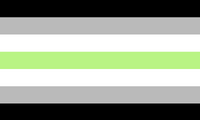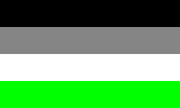No edit summary Tag: Visual edit |
m (Added a bit about gender apathetic being related to agender) Tags: Visual edit Mobile edit Mobile web edit |
||
| Line 3: | Line 3: | ||
| caption = |
| caption = |
||
| altname = Genderless <small>(some definitions)</small> |
| altname = Genderless <small>(some definitions)</small> |
||
| + | Gender apathetic <small>(some definitions)</small> |
||
| term = [[Gender identity]] |
| term = [[Gender identity]] |
||
| spectrum = [[Transgender]] / [[Non-binary]] |
| spectrum = [[Transgender]] / [[Non-binary]] |
||
| Line 11: | Line 12: | ||
| sexuality = |
| sexuality = |
||
| different = *Genderless <small>(some definitions)</small> |
| different = *Genderless <small>(some definitions)</small> |
||
| + | *Gender apathetic <small>(some definitions)</small> |
||
* [[Gender neutral]] |
* [[Gender neutral]] |
||
* [[Gender non-conforming]] |
* [[Gender non-conforming]] |
||
Revision as of 06:57, 26 June 2022
Agender, also known as genderless,[1][2][3] can be one of the A terms in the acronym LGBTQIA+.[1][2] It is a gender identity that has been defined multiple ways, including:[3]
- Not identifying with any gender, particularly the gender binary; not male, not female, not both or neither.[1]
- Feeling gender neutral.[3]
- The absence of a feeling of gender[2] or lacking gender.[3]
- Rejecting the concept of gender.[3]
- Feeling the concept of gender is personally irrelevant.[3]
While agender is typically considered under the transgender and/or non-binary umbrellas, different individuals may or may not identify with those terms; those who do use them do not need to transition physically, legally, or socially to be agender.[2][4] Some agender people are genderfluid, meaning their gender identity is not static and changes from being agender.[2] Agender individuals can have any type of gender expression and use any set of pronouns or no pronouns at all just like any other individual can.[5] Agender identities are not exclusive to certain assigned genders at birth or sexual orientations and romantic orientations, just like majority of the genders that are often or always included in the non-binary and/or transgender umbrellas[6] and the orientation terms used by individuals who are agender may potentially challenge the idea of "same" and "opposite" gender attraction.[2]
Etymology
The term "agender" is comprised of the prefix "a-", which comes from the Ancient Greek ἀ-, meaning "not" or "without",[7] and "gender". The literal meaning of the term agender is thus "genderless" or "without gender".[3]
Community
Agender Pride Day has been observed each year on May 19 since 2017. As such, it is one of the newer LGBTQIA+ awareness days.[8]
History
While agender as an identity is not new, the word describing the gender experience, or lack thereof, only surfaced on the internet in 2000 on a forum called UseNet during a religious discussion with someone referring to God as being agender.[9] According to the Oxford English Dictionary, the term was used again on the same forum 5 years later, this time to refer to people,[10] and from then on, the term started to gain traction. It was used in a profile done by the New York Times of "Generation LGBTQIA",[11] and US history was made on March 10, 2017, when the Multnomah County Court of Oregon granted Patch a "General Judgment of Name and Sex Change", thus becoming the first, legally agender person in the US. The same judgment also allowed them to change names and become mononymous—meaning only having one name instead of a given name and a surname.[12]
Flag
The agender flag was created on February 18, 2014, by Salem, who identifies as an agender and panromantic demisexual with they/she pronouns.[13] An artist from New York, they created the flag at a time when Tumblr was seeing an influx of identity expressions, making it hard for people to distinguish the valid identities from the "online fads". Capitalizing on the momentum, Salem created the agender flag (among others)[14] to increase visibility for agender identities and reclaim their own identity.[13] The transgender flag served as a primary influence as Salem wanted to have a similar stripe pattern and symmetry.[14]

This flag was created to increase visibility for agender people, as well as a way for the artist to reclaim their own identity.
The flag design features 7 horizontal stripes, from top to bottom: black, gray, white, green, white, gray, and black again. The black and white stripes represent the agender experience, the gray the demi-agender experience, and the green refers to agender being part of the wider non-binary community as those who identify outside of the gender binary.[4] While the monochrome on the flag is representative of a spectrum of internal identities, ranging from people with a strong feeling of gender to those without, the green in the middle was deliberately chosen for being the invert of the shade of purple on the non-binary flag that refers to those who relate to the gender binary, as purple is a combination of pink and blue, the traditional female and male colors, thus highlighting that agender does not fall between the binary spectrum at all.[14]

An homage to the original flag was created in 2021.
While Salem's design remains the most widespread, more agender flags were created. In 2021, Mars created a four-striped homage to the original, using similar colors and meanings, though with a deliberately higher-contrast design and fewer stripes to emphasize the solidarity of agender people who may also be lesbian, gay, bisexual, non-binary, trans, ace, or any other sexual, romantic, and gender identities. By reducing the repetition of the colors, Mars sent out the message that "No matter what else we are, all agender people are wholly equally agender."[15]
Distinction
Gender apathy
Gender apathy is different from agender in that the individual could be cisgender or non-binary, but they do not care or think about it. People who are gender apathetic are not fazed by gendered comments and do not feel discriminated against for being their gender, even when they are. They feel no pull to join any gender pride groups and do things considered against gender norms without thinking about it.[16]
Genderless
Genderless and agender are sometimes considered separate terms. In definitions that separate them, they are seen as having a strong overlap between the experiences, but with the definition of genderless having a stronger emphasis on completely lacking a gender.[17]
Gender neutral
- Main article: Gender neutral
Gender neutral means "not gendered", which places it right within the meaning of agender, i.e., "without a gender". However, as opposed to agender, gender neutral is not a term used to describe people. This term is used to refer to language (such as pronouns or neutral greeting or job titles), locations (like bathrooms), or other aspects of society.[18]
Gender non-conforming
- Main article: Gender non-conforming
The difference between agender and gender non-conforming people lies in the fact that agender people generally experience a lack of gender whereas a gender non-conforming person is someone who does not fully conform to the expectations around their gender that their society enforces. While some gender non-conforming people may identify as agender, many do not, and they simply do not follow the expected gender norms. This can out itself in the way they express themselves, the roles they assume, or any other aspect of their gender.[6]
Gendervoid
Although agender and gendervoid are similar and can be used interchangeably, gendervoid puts more emphasis on feeling like one's gender is literally a void.[19] A gendervoid person may feel like there is an empty place where a gender would/should be but simply is unable to experience gender.[6]
Non-binary
- Main article: Non-binary
As non-binary is an umbrella term for all genders falling outside of the gender binary, agender is often placed under this term; however, this does not mean that all non-binary people are agender, as many may experience gender whereas agender people do not.[6][18]
Neutrois
- Main article: Neutrois
Neutrois is a non-binary gender identity with a strong emphasis on gender neutrality. It is considered part of the genderqueer and transgender umbrellas.[20] Some people identify as both agender and neutrois.[1]
Controversy
| Expansion needed | |
| This section is incomplete. You can help LGBTQIA+ Wiki by expanding it. |
If there has been a specific variety of this identity-phobic discourse that has led to discrediting it please detail that here. If there have been similar -phobic discourses around popular flags, it can also be documented in this section.
Perceptions and discrimination
| Expansion needed | |
| This section is incomplete. You can help LGBTQIA+ Wiki by expanding it. |
This section focuses more on the specific kinds of discrimination and oppression that these people may face. Examples would be mentioning systematic transphobia and non-binary erasure on the page for agender, mentioning rates of mental health issues in this group, etc.
Media
Music
- Angel Haze - American rapper and singer who identifies as pansexual and agender.
Resources
- Neutrois - a resource for anyone who is or thinks they may be neutrois, agender, or genderless.
